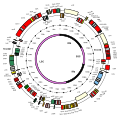Artificial skin: Difference between revisions
CSV import |
CSV import |
||
| Line 1: | Line 1: | ||
== Arabidopsis thaliana == | |||
'''''Arabidopsis thaliana''''', commonly known as thale cress, is a small flowering plant native to Eurasia. It is a member of the [[Brassicaceae]] family, which also includes species such as [[cabbage]] and [[mustard]]. ''Arabidopsis thaliana'' is widely used as a model organism in plant biology and genetics due to its small genome, short life cycle, and ease of cultivation. | |||
== | === Description === | ||
''Arabidopsis thaliana'' is a small, herbaceous plant that typically grows to a height of 20–25 cm. It has a rosette of basal leaves and produces a flowering stem with small, white flowers. The plant is an annual, completing its life cycle in about six weeks under optimal conditions. | |||
== | === Genome === | ||
The genome of ''Arabidopsis thaliana'' was the first plant genome to be sequenced, completed in 2000. It consists of five chromosomes and approximately 135 million base pairs, encoding around 27,000 genes. This relatively small genome size makes it an ideal model for genetic studies. | |||
== | === Research Applications === | ||
''Arabidopsis thaliana'' is extensively used in research to study plant development, genetics, and physiology. It has been instrumental in understanding the [[ABC model of flower development]], [[phototropism]], and [[plant hormone]] signaling pathways. The plant's genetic tractability allows for the creation of mutants to study gene function. | |||
== | === Mutants === | ||
Mutants of ''Arabidopsis thaliana'' have been used to study various biological processes. For example, mutants with altered flower development have provided insights into the genetic control of floral organ identity. Other mutants have been used to study responses to environmental stresses such as drought and salinity. | |||
[[Category: | === Ecological and Evolutionary Studies === | ||
[[Category: | In addition to laboratory research, ''Arabidopsis thaliana'' is used in ecological and evolutionary studies. Its natural populations exhibit a wide range of genetic diversity, making it a valuable system for studying adaptation and natural selection. | ||
[[Category: | |||
== Related pages == | |||
* [[Brassicaceae]] | |||
* [[Model organism]] | |||
* [[Plant genetics]] | |||
* [[Genomics]] | |||
== Gallery == | |||
<gallery> | |||
File:194_Arabidopsis_thaliana,_Turritis_glabra.jpg|''Arabidopsis thaliana'' in its natural habitat | |||
File:Müürlooga_(Arabidopsis_thaliana)_lehekarv_(trihhoom)_311_0804.JPG|Trichomes on ''Arabidopsis thaliana'' leaf | |||
File:Arabidopsis_mutants.jpg|Mutants of ''Arabidopsis thaliana'' | |||
File:Plastomap_of_Arabidopsis_thaliana.svg|Plastid map of ''Arabidopsis thaliana'' | |||
File:ABC_flower_development.svg|ABC model of flower development | |||
File:ArabidopsisPlantPathology.jpg|''Arabidopsis thaliana'' in plant pathology research | |||
File:Microbial_consortia_naturally_formed_on_the_roots_of_Arabidopsis_thaliana.webp|Microbial consortia on ''Arabidopsis thaliana'' roots | |||
</gallery> | |||
[[Category:Model organisms]] | |||
[[Category:Brassicaceae]] | |||
[[Category:Plant genetics]] | |||
Latest revision as of 18:39, 11 February 2025
Arabidopsis thaliana[edit]
Arabidopsis thaliana, commonly known as thale cress, is a small flowering plant native to Eurasia. It is a member of the Brassicaceae family, which also includes species such as cabbage and mustard. Arabidopsis thaliana is widely used as a model organism in plant biology and genetics due to its small genome, short life cycle, and ease of cultivation.
Description[edit]
Arabidopsis thaliana is a small, herbaceous plant that typically grows to a height of 20–25 cm. It has a rosette of basal leaves and produces a flowering stem with small, white flowers. The plant is an annual, completing its life cycle in about six weeks under optimal conditions.
Genome[edit]
The genome of Arabidopsis thaliana was the first plant genome to be sequenced, completed in 2000. It consists of five chromosomes and approximately 135 million base pairs, encoding around 27,000 genes. This relatively small genome size makes it an ideal model for genetic studies.
Research Applications[edit]
Arabidopsis thaliana is extensively used in research to study plant development, genetics, and physiology. It has been instrumental in understanding the ABC model of flower development, phototropism, and plant hormone signaling pathways. The plant's genetic tractability allows for the creation of mutants to study gene function.
Mutants[edit]
Mutants of Arabidopsis thaliana have been used to study various biological processes. For example, mutants with altered flower development have provided insights into the genetic control of floral organ identity. Other mutants have been used to study responses to environmental stresses such as drought and salinity.
Ecological and Evolutionary Studies[edit]
In addition to laboratory research, Arabidopsis thaliana is used in ecological and evolutionary studies. Its natural populations exhibit a wide range of genetic diversity, making it a valuable system for studying adaptation and natural selection.
Related pages[edit]
Gallery[edit]
-
Arabidopsis thaliana in its natural habitat
-
Trichomes on Arabidopsis thaliana leaf
-
Mutants of Arabidopsis thaliana
-
Plastid map of Arabidopsis thaliana
-
ABC model of flower development
-
Arabidopsis thaliana in plant pathology research
-
Microbial consortia on Arabidopsis thaliana roots






